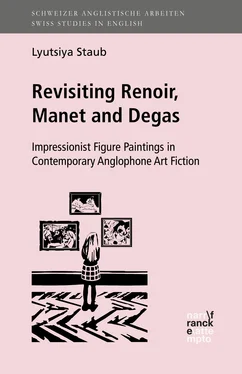And so the picture becomes more wonderful to us than it really is, and reveals to us a secret of which, in truth, it knows nothing […]. It treats the work of art simply as a starting-point for a new creation. It does not confine itself […] to discovering the real intention of the artist and accepting that as final. And in this it is right, for the meaning of any beautiful created thing is, at least, as much in the soul of him who looks at it, as it was in his soul who wrought it. Nay, it is rather the beholder who lends to the beautiful thing its myriad meanings, and makes it marvellous for us, and sets it in some new relation to the age, so that it becomes a vital portion of our lives, and a symbol of what we pray for, or perhaps of what, having prayed for, we fear that we may receive. (985)
Therefore, ekphrasis is an example of both “the creative act itself – through the Greek mimesis , imitating, copying – and of the secondary critical act of commentary, description, revelation” (Cheeke 185). Similarly, Sager Eidt applies an “expanded definition of ekphrasis as an interpretive tool” (10) and demonstrates how “different genres in either modality influence the way the reader or viewer reconstructs the implications of a work of art” (10). Such an understanding of ekphrasis is crucial for the further analysis of texts in the present study, where the term ekphrasis is used to refer to texts in which a pictorial source is described and interpreted.
One of the most influential and widely cited definitions of ekphrasis has been formulated by Heffernan, who interprets it as “the verbal representation of a visual representation” (3). On the one hand, by regarding ekphrasis as “verbal representation”, Heffernan departs from seeing it as exclusively descriptive. On the other, he limits ekphrastic practice to works of representational art. Heffernan points out that his definition
excludes a good deal of what some critics would have ekphrasis include – namely literature about texts. It also allows us to distinguish ekphrasis from two other ways of mingling literature and the visual arts: pictorialism and iconicity. What distinguishes those two things from ekphrasis is that both of them aim chiefly to represent natural objects and artifacts rather than works of representational art. (3)
In seeing ekphrasis as a “narrative response to pictorial stasis” (4), Heffernan disagrees with Krieger’s understanding of ekphrasis as a device used to “interrupt the temporality of discourse, to freeze it during its indulgence in spatial exploration” ( Ekphrasis: The Illusion of the Natural Sign 7). He also disagrees with Krieger’s idea that “language – in spite of its arbitrary character and its temporality – freeze[s] itself into a spatial form” (“The Problem of Ekphrasis ” 5). This applies equally to Steiner, who defines ekphrasis as the “mode of representing temporal events as action stopped at its climactic moment” ( Pictures of Romance 13), or a pregnant moment “in which a poem aspires to the atemporal ‘eternity’ of the stopped-action painting” (13-14). Conversely, Heffernan recognises ekphrasis as “dynamic and obstetric” (5) and argues that it “typically delivers from the pregnant moment of visual arts its embryonically narrative impulse, and thus makes explicit the story that visual art tells only by implication” (5). According to Heffernan, “[t]o represent a painting or sculptured figure in words is to evoke its power – the power to fix, excite, amaze, entrance, disturb, or intimidate the viewer” (7). The storytelling impulse of ekphrasis is closely allied to its interpretative nature, namely, that of creating new meanings and giving new interpretations to an artwork. The work of art is integrated into the narrative process to such an extent that it acquires life of its own and shows its meaning from a different perspective.
Heffernan’s theory has attracted many followers, one of whom is Clüver, who modifies the original definition of ekphrasis by accepting the first part – “verbal representation” – but introducing major changes in the second. Clüver’s definition of ekphrasis becomes: “ the verbal representation of a real or fictitious text composed in a non-verbal sign system ” (“Ekphrasis Reconsidered” 26, emphasis in original). This definition clearly expands the range of the objects for ekphrastic representation; “it covers architecture, as well as […] music and non-narrative dance” (26). One year later Clüver reformulates his definition by replacing “verbal representation” with “verbalization”: “ ekphrasis is the verbalization of real or fictitious text composed in a non-verbal sign system ” (“Quotation, Enargeia” 49, emphasis in original). He validates this final adjustment by differentiating between “verbalization” and “verbal representation”:
Verbalization is a form of verbal re-presentation that consists of more than a name or a title […]. The verbalization may form part of a larger piece of writing or, as in the case of a number of Bildgedichte , may constitute the entire text. It can take forms that are not descriptive in a conventional way; but as verbalization it would retain a certain degree of enargeia. (45)
Thus, verbalization has less of a connection to mimesis than verbal representation, but at the same time is still linked to enargeia , a concept central to ekphrasis. Among Heffernan’s other followers is Blackhawk, who regards ekphrasis as “verbal description of a visual representation” (1) and Bilman, who maintains that ekphrasis is “the verbal representation of a visual work of art” (1). However, due to the variety of texts that can be grouped under the rubric of ekphrastic writing, as well as a growing number of au courant inter-art encounters in ekphrastic practice, the modern approach to ekphrasis is based on an understanding that there cannot be only one exclusive definition. Therefore, Yacobi extends the concept of ekphrasis by referring to it as an umbrella term that “subsumes various forms of rendering the visual object into words” (“Pictorial Models” 600). By the same token, Robillard refrains from interpreting ekphrasis at all, mentioning the possible risks of working towards a single definition:
One of the risks of trying to arrive at single definition of ekphrasis , then, is that these immediately define the boundaries of both art and literature, neither of which have, in the course of their history, proven particularly stable entities. (54)
Furthermore, Scholz, exploring the possible definitions and functions of ekphrasis, raises the following questions: “Should ekphrasis therefore be treated as a specification of intertextuality? Or should we treat it, like ‘narration,’ very broadly as a term for a mode of writing – to be contrasted with ‘description,’ ‘argumentation’ or ‘dialogue’?” (74). He continues his argument by saying that
[c]lassifying ekphrasis as a literary genre will raise questions about the formal and contentual [sic] textual markers, and about the referential characteristics which distinguish ekphrasis from other (descriptive) genres. Classifying it as a macrostructure will involve focusing on the possibility that ekphrasis may possess certain species-specific syntactic features. Classifying it as variant of intertextuality will lead to highlighting kinds and degrees of similarities and differences with the (pictorial or sculptural) ‘pretext’ of keeping with the pragmatic thrust of Classical rhetoric, lay greater stress on the intended effect of ekphrasis on the listener/reader, thereby shifting the focus of attention from the ekphrastic text to the ‘mental’ aspects of the communicative situation initiated by such an ekphrastic text. (74)
Читать дальше












